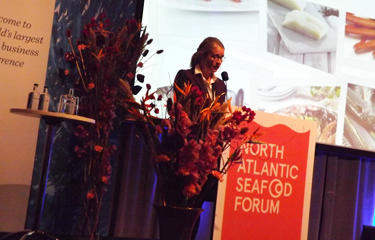Norway’s government will provide a platform for the continued growth of the country’s aquaculture sector, but it wants commercial players to do the heavy lifting in regard to overcoming its environmental challenges.
Addressing the North Atlantic Seafood Forum (NASF) 2020 on behalf of the Norwegian Ministry of Fisheries and Seafood, State Secretary Trine Danielsen described Norwegian aquaculture as “a strong and global industry,” and promised that its further growth would be supported in order to “meet the rising demand for nutritional seafood” in the years ahead.
“This is the nation’s goal. The Norwegian government has a great ambition for the aquaculture industry. This is not a difficult position to hold as we are already talking about an eager, creative, ambitious and forward-looking industry,” Danielsen said. “The industry itself is doing the hard work. They are the developers and the financial risk-takers. We, the politicians, are merely providing the conditions for sustainable growth.”
Danielsen, who was appointed state secretary a month ago and has a long association with the aquaculture industry, expects further growth from the sector. But she also cautioned that it has “a clear responsibility” to operate sustainably and solve its environmental challenges, particularly from sea lice.
In 2017, a new national “traffic light” system was introduced dividing Norway’s coast into 13 defined production areas. Based on scientific calculations, these are colored green, yellow, and red according to the perceived risk of lice-induced mortality on wild salmon numbers.
“The regulations are an effort to allow the industry to grow only in the areas where it is environmentally sustainable,” she said. “Unfortunately, this year is the first time that production capacity in two key areas will be reduced. This is negative for the industry and a loss for the nation.”
In the longer-term, new farming concepts and technologies can contribute to decreasing the industry’s environmental impact and will also lead to the release of new areas for aquaculture in the fjords and open ocean, Danielsen said.
“I’m glad to say that in Norway these days, new and exciting concepts are now in the making – both offshore and onshore in open settings and closed containment systems. New innovative concepts will continue to strengthen the already world-leading aquaculture supply for now and forever – if we do it right.”
Danielsen told delegates that strong lines of collaboration and knowledge sharing between the industry, academia, and government are key to the further sustainable expansion of the industry.
“Cooperation between these three partners has proven to be one of the success factors for developing the aquaculture industry into what it is today. Norway is the world’s second largest seafood exporter and ensuring market access for Norwegian seafood products is the key priority for the government,” she said. “Salmon produced in Norwegian waters are exported to more than 140 markets around the world. The industry strictly observes the requirements set in the international markets. It knows the environmental consequences of seafood production must be under control. It is about animal welfare. It is about the bottom line. And ultimately, it’s about the reputation of the industry. These concerns are all linked. By choosing Norwegian salmon, customers trust that we are producing it sustainably and without any suffering by the fish. Here lies the route to the sector’s reputation.”
The Norwegian government aims to smooth the way and augment the existing resources of the aquaculture industry, Danielsen said.
“Our government will continue to be an active supporter for the seafood industry and try to stimulate development. We are continuously working to develop and improve the industry’s framework conditions – to strengthen the competitive forces,” she said. “However, the industry sits in the driver’s seat. We, the politicians and the bureaucracy, are in the back. And there is an ocean of opportunity out there.”
Photo courtesy of Jason Holland/SeafoodSource







